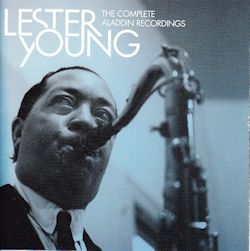CD 1
1. Indiana
2. I Can't Get Started
3. Tea for Two
4. Body and Soul
5. D.B.Blues
6. Lester Blows Again
7. These Foolish Things
8. Jumpin' at Mesner's
9. It's Only a Paper Moon
10. After You've Gone
11. Lover Come Back to Me
12. Jammin' with Lester
13. You're Driving Me Crazy
14. New Lester Leaps In
15. Lester's Be Bop Boogie
16. She's Funny That Way
17. Sunday
18. S.M.Blues
19. Jumpin' with Symphony Sid
20. No Eyes Blues
21. Sax-O-Be-Bop
22. On the Sunny Side of the Street
23. One O'Clock Jump
24. Jumpin' at the Woodside
CD 2
1. Movin' with Lester
2. Easy Does It
3. Easy Does It (alt take)
4. I'm Confessin'
5. Lester Smooths It Out
6. Just Cooling
7. Tea for Two
8. East of the Sun
9. The Sheik of Araby
10. Something to Remember You By
11. Untitled Instrumental
12. Please Let Me Forget
13. He Don't Love Me Anymore
14. Pleasing Man Blues
15. See See Rider
16. It's Better to Give Than Receive
17. Back to the Land
18. I Cover the Waterfront
19. Somebody Loves Me
20. I've Found a New Baby
21. The Man I Love
22. Peg O' My Heart
23. I Want to be Happy
24. Mean to Me
Lester Young - Tenor sax on all tracks, with:
Willie Smith - Alto sax
Howard McGhee - Trumpet
Vic Dickenson - Trombone
Nat `King' Cole - Piano
Joe Albany - Piano
Dodo Marmarosa - Piano
Chuck Wayne - Guitar
Dave Barbour - Guitar
Red Callender - Bass
Chico Hamilton -Drums
Roy Haynes - Drums
Tiny Kahn - Drums
and many others.
40 tracks on this double CD comprise all the music that Young recorded for Aladdin Records in the 1940s, most of it recorded between 1945 and 1947 after
Young's unhappy experience in the US Army. The additional 8 tracks (17 to 24 on CD 2) were originally recorded on Norman Granz's label, Norgran, in
March/April 1946 with an all-star trio comprising Young, Nat `King' Cole and Buddy Rich. Cole is also present on the first four tracks on CD 1 which were
recorded in 1942. Unfortunately, the recording quality on these four tracks is poor with a lot of hiss. The Aladdin tracks are of an acceptable quality and
are the same as those issued on Blue Note in 1995.
Some jazz historians have taken the view that Young was never the same musician following his dishonourable discharge from the Army but there is little
evidence of any deterioration in the quality of his playing on these recordings. D.B. Blues (for Detention Barracks) and Lester Blows Again are imbued with the relief he must have felt at being reunited with his saxophone. By August, 1946, he is in expansive mood and
sounds as if he could happily have blown chorus after chorus on New Lester Leaps In. Young seems to relish the presence of bop pianists Albany,
Marmarosa and Thornton in the various rhythm sections and Roy Haynes's assertive drumming clearly fires up Young on the February, 1947 date ( disc 1 tracks
23-24 and disc 2 tracks 1-3).
With guitarist Chuck Wayne (disc 2 tracks 7-10) in December, 1947, Young is in a more reflective mood and showing his gentle, whimsical side on the lovely East of the Sun. The untitled track that follows this session finds Young as a member of Helen Humes' All-Stars with the saxophonist sharing brief
solos in support of the singer on tracks 12-16 with Willie Smith, Dave Barbour and an uncredited Snooky Young on trumpet.
The trio tracks with Cole and Rich (using brushes throughout) are full of lively solos with the three musicians having the most fun on I Want to be Happy.
Lester Young fans will almost certainly already own these recordings, but for students of the saxophone they are essential listening as a means of
appreciating how Young became such a major and influential figure on the tenor saxophone.
George Stacy
